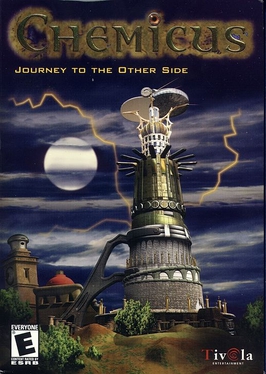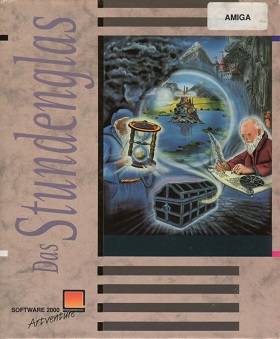
Simon the Sorcerer is a 1993 point-and-click adventure game developed and published by Adventure Soft, for Amiga and MS-DOS. The game's story focuses on a boy named Simon who is transported into a parallel universe of magic and monsters, where he embarks on a mission to become a wizard and rescue another from an evil sorcerer. The game's setting was inspired by the novels of the Discworld series, and incorporates parodies on fantasy novels and fairy tales, such as The Lord of the Rings and Jack and the Beanstalk. The lead character's design was inspired by that of the fictional British television character Blackadder, with the character voiced by Chris Barrie in the CD re-release.
Gobliiins is a puzzle adventure video game series, consisting of five entries, released by Coktel Vision for the Amiga, Atari ST, DOS, Macintosh, iOS and Windows platforms. The first three titles were released in the early 1990s, the fourth in 2009, and fifth in 2023. The visual look of the series and its characters were created by French artist Pierre Gilhodes, whose style was used in another game from Coktel Vision: Woodruff and the Schnibble of Azimuth.

Conquests of the Longbow: The Legend of Robin Hood is a graphic adventure game designed by Christy Marx and published by Sierra On-Line in 1991. It is the second and final part of the Conquests series, which begins with Conquests of Camelot: The Search for the Grail. It features VGA graphics and Sierra's standard icon-driven interface first seen in King's Quest V.

King's Quest VI: Heir Today, Gone Tomorrow is a point-and-click adventure game, first released in 1992 as the sixth installment in the King's Quest series produced by Sierra On-Line. Written by Roberta Williams and Jane Jensen, King's Quest VI is widely recognized as the high point in the series for its landmark 3D graphic introduction movie and professional voice acting. King's Quest VI was programmed in Sierra's Creative Interpreter and was the last King's Quest game to be released on floppy disk. A CD-ROM version of the game was released in 1993, including more character voices, a slightly different opening movie and more detailed artwork and animation.

Rise of the Dragon, released in 1990 by Dynamix, marks the company's venture into the cyberpunk genre, distinct from its usual portfolio of action and flight simulators. This graphic adventure game is set in a future dystopian version of Los Angeles, circa 2053, and follows the story of detective William 'Blade' Hunter as he investigates the death of the mayor's daughter, linked to a dangerous new drug, MTZ. The gameplay combines detective work, strategy, and action. Players must solve puzzles that influence the storyline, interact with characters who remember past choices, and tackle action sequences. If players fail these sequences multiple times, the game may offer to automatically complete them.

There have been several video games based on the 1991 film Hook. A side-scrolling platform game for the Nintendo Entertainment System (NES) and Game Boy was released in the United States in February 1992. Subsequent side-scrolling platform games were released for the Commodore 64 and the Super Nintendo Entertainment System (SNES), and an arcade beat ‘em up by Irem later in 1992, followed by versions for the Sega CD, Sega Genesis, and Sega's handheld Game Gear console in 1993.

Curse of Enchantia is a graphic adventure game developed and released by the British video game company Core Design for MS-DOS and the Amiga in 1992. The game tells the comic fantasy story of Brad, a teenage boy from modern Earth who was magically abducted to the world of Enchantia by an evil witch-queen. He needs to escape and find a way back to his own dimension.

Quest for Glory: So You Want to Be a Hero is a 1989 adventure game/role-playing game hybrid, designed by Lori Ann Cole and published by Sierra On-Line for MS-DOS. It is the first game in the Quest for Glory series, and has been credited for being a genre-defining game, as it tried to mix graphical adventure gaming with role-playing-like elements such as statistic building that would actually affect the ability to accomplish certain parts of the game. The game has a satirical and silly tone. Ports for the Amiga, Atari ST, and NEC PC-9801 were released in the early 1990s. A VGA remake, titled Quest for Glory I: So You Want to Be a Hero, was released in 1992 for DOS and later in 1994 for Mac OS.

The Immortal is an isometric action-adventure game originally created by Will Harvey and released by Electronic Arts in 1990 for the Apple IIGS. It was soon ported to the Amiga, Atari ST, DOS, Nintendo Entertainment System, and Genesis. A wizard is attempting to find his mentor in a large and dangerous labyrinth. It has a high degree of graphic violence. In 2020, the NES port was re-released on the Nintendo Switch Online service, while the Genesis port was re-released on the Piko Collection Collection 1 cartridge for the Evercade.

Castle of Dr. Brain is an educational video game released in 1991 by Sierra On-Line. It is a puzzle adventure game.

Wonderland, published in 1990 by Virgin Games, is an interactive fiction game developed by Magnetic Scrolls based on Lewis Carroll's Alice in Wonderland. While playing as Alice, the player goes on a journey solving puzzles in order to find the way back home from Wonderland. With numerous locations to explore, the game introduced characters from the original book to help with the journey in Wonderland. First introducing the magnetic windows system, Wonderland received positive reviews upon release.

Elvira: Mistress of the Dark is a horror adventure/role-playing video game developed by Horror Soft and released by Accolade in 1990 for the Amiga, Atari ST, Commodore 64 and MS-DOS computers. It was Horror Soft's second published game after 1989's Personal Nightmare and stars the actress Cassandra Peterson as her character Elvira.

The Secret of the Nautilus is a 2002 adventure video game, inspired by Jules Verne's 1870 science fiction novel Twenty Thousand Leagues Under the Seas. It was developed by Cryo Interactive and released for Microsoft Windows based PCs.

Adventure at the Chateau d'Or is a 2001 adventure game, developed and published by Karma Labs.

Daughter of Serpents is a 1992 point-and-click adventure game developed by Eldritch Games and published by Millennium Interactive for DOS. The game was released in the English, Italian, French, German and Spanish languages. It was planned to be ported to Amiga by December, but ultimately that was never released.

Chemicus: Journey to the Other Side is a 2001 educational adventure video game by Heureka-Klett as part of Tivola's "Quest for Knowledge" series. A sequel named Chemicus II: Die versunkene Stadt was released in 2002. The game was originally released in Germany.

Bioscopia: Where Science Conquers Evil is a 2001 educational adventure video game. It is a sister game to Physicus and Chemicus.

Secrets of the Luxor is a 1996 adventure video game developed by American studio Mojave and published by Ubi Soft for Macintosh, Windows, and Windows 3.x.

Das Stundenglas is a German text adventure game published in 1990 by Software 2000 and developed by Weltenschmiede, and released for Amiga, Atari ST and DOS. Das Stundenglas is part of a text adventure trilogy; it is succeeded by Die Kathedrale (1991) and Hexuma (1992). The trilogy lacks an overarching plot, and in each entry the setting, role of the protagonist, and goal differ between each game. Games in the trilogy do not require knowledge of the other entries and may be played as standalone games.

Nippon Safes Inc. is a point-and-click adventure game developed by Italian developer Dynabyte. It was released in 1992 for MS-DOS and Amiga computers. The game is the predecessor to The Big Red Adventure and features cartoonish, comics-style graphics and a unique icon-based interface. In 2021 the game was declared freeware by the original authors of the game.


















